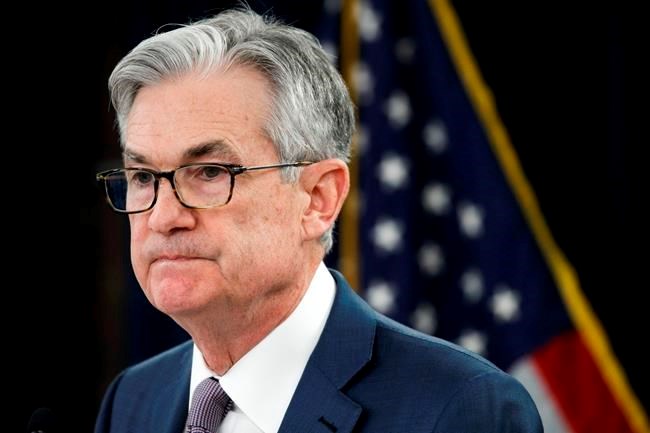WASHINGTON — Confronted with an economy gripped by recession and high unemployment, the Federal Reserve
At the same time, the Fed said it will keep buying about $120 billion in Treasury and mortgage bonds each month to hold low longer-term borrowing rates to try to spur spending and growth.
The Fed’s message Wednesday, in a statement after its latest policy meeting and in a virtual news conference by Chair Jerome Powell, was that it’s ready to do more to help support a shaky economy that faces significant uncertainty. Powell acknowledged that he and other Fed policymakers have only a hazy view of how the economy will fare in the coming months, largely because no one knows how quickly businesses may regain their health or resume a normal pace of hiring.
By pegging its short-term rate to zero for the next two-plus years, the Fed is seeking to induce consumers and businesses to spend enough to sustain an economy depressed by the coronavirus. Its benchmark rate influences a range of loans, including for homes, autos and credit cards.
“It is clear that the Fed does not anticipate a V-shaped economic recovery and is positioned to move forcefully to support the economy,” said Joe Brusuelas, chief economist at RSM, referring to an economy that snaps back as quickly as it shrank.
Stock prices initially rallied modestly after the Fed issued its latest policy statement at 2 p.m. Eastern time before most indexes closed in negative territory.
Powell noted that the job market “may have hit bottom” last month, when employers added a surprise 2.5 million jobs, according to a government report last Friday. But he underscored that nearly 21 million Americans remain unemployed and that one solid jobs report was hardly enough to ensure that the economy is back on track — or alter the Fed's intention to keep rates ultra-low.
“We’re not going to overreact to a single data point," he said. “We're not thinking about raising rates. We're not even thinking about thinking about raising rates."
In the statement, the Fed also credited its emergency lending programs for reviving the flow of credit to households and businesses, after markets had locked up in March when investors sold a range of securities to boost their cash holdings.
The central bank noted that the viral outbreak has caused a plunge in economic activity and surge in job losses. Fed officials estimate that the economy will shrink 6.5% this year, in line with other forecasts, before expanding 5% in 2021. They foresee the unemployment rate at 9.3%, near the peak of the last recession, by year's end. The rate is now 13.3%.
The projections suggest that the Fed doesn't see the economy fully recovering from the recession until 2023.
“My assumption is that there will be a significant chunk — well into the millions — of people who don’t get back to their old jobs,” Powell said. "It could be some years" before they find work.
At his news conference, Powell began by acknowledging the widespread protests in the aftermath of George Floyd's killing that have called attention to racial injustices.
“I want to acknowledge the tragic events that have put a spotlight on (issues of racism),” Powell said. “There is no place at the Federal Reserve for racism, and there should be no place in our society.”
Since March, the Fed has slashed its benchmark short-term rate, bought $2.1 trillion in Treasury and mortgage bonds to inject cash into markets and rolled out nine lending programs to try to keep credit flowing smoothly.
Powell said Fed policymakers now want to take some time “to get a better understanding of the economy’s trajectory” and how they might do more to bolster the economy.
One possible move, he said, would be to provide more specific guidance about how long the Fed will keep short-term rates low. This guidance could help the economy by reducing the likelihood that investors will send borrowing costs higher before the Fed intends.
The policymakers could, for example, announce at a future meeting that they will put off any rate hike until inflation returns to its 2% target.
Another option the Fed discussed, Powell said, is to peg more rates at nearly zero, such as those on two-year or three-year Treasury notes, to underscore their determination to keep rates very low for that length of time. Australia's central bank has adopted such a policy.
But Powell said it is still an “open question” as to whether the Fed would take that approach.
The Fed’s actions are credited with having helped fuel an extraordinary rally in the stock market, which has nearly regained its pre-pandemic high after a dizzying plunge in March.
And by committing to buy corporate bonds, thereby reinvigorating the market for such securities, the Fed has also ensured that corporations can continue to borrow. Its initiatives also include a first-ever program through which the Fed is buying state and local government debt to support the municipal bond market.
Many economists say those steps have prevented the downturn from worsening, by keeping credit flowing. This week, the National Bureau of Economic Research, the official arbiter of recessions, declared that the U.S. economy entered a recession in February.
One challenge for the Fed now is to shift its focus from the emergency actions it took in March and April to try to carry the economy through a shutdown, to what steps it will take to stimulate a recovery as businesses increasingly reopen.
For now, Fed officials likely feel little pressure to act further because few investors expect them to make any changes to their benchmark rate anytime soon. Though the Fed could technically cut rates into negative territory, Powell has largely rejected negative rates as an option.
___
AP Economics Writer Martin Crutsinger contributed to this report.
Christopher Rugaber, The Associated Press

